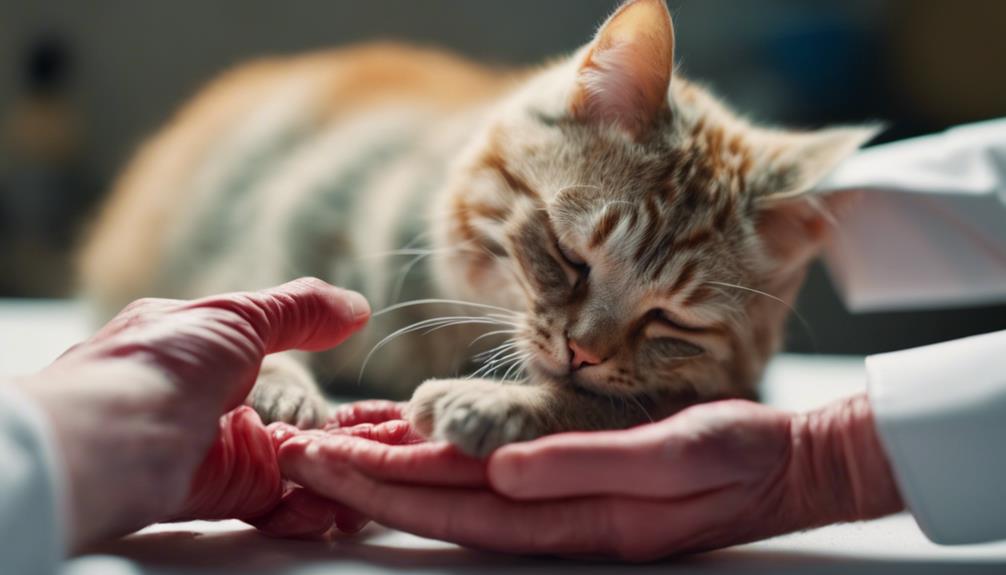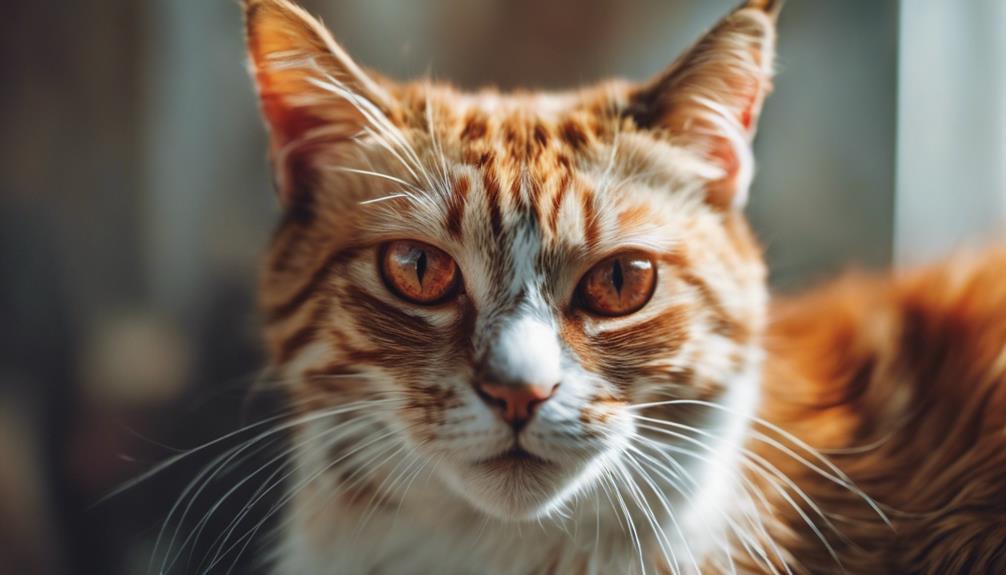Feline scabies, caused by the Notoedres cati mite, presents a pressing concern for cat owners and veterinarians alike.
The signs of this parasitic infestation can be subtle initially, but the impact on a cat's health can escalate rapidly if left untreated.
Understanding the symptoms, treatment options, and prevention measures is essential for safeguarding feline companions against this persistent threat.
As we explore the intricacies of feline scabies alert, the intricate dance between identification, treatment, and prevention unfolds, shedding light on crucial steps to ensure the well-being of our beloved feline friends.
Key Takeaways
- Prompt treatment is crucial to alleviate symptoms and prevent transmission.
- Recognize symptoms early to initiate timely intervention and ensure effective treatment.
- Tailored treatment plans from a vet are essential for feline scabies management.
- Preventive measures like isolation, cleaning, and flea control aid in controlling feline scabies.
Feline Scabies Causes
Caused by the Notoedres cati mite, feline scabies is a contagious skin condition primarily affecting cats due to the life cycle of these microscopic parasites. These mites burrow into the skin of the feline host, leading to intense itching, hair loss, sores, and crust formation.
The transmission of Notoedres cati occurs through direct contact with an infested cat, making it crucial to isolate affected animals to prevent further spread within multi-pet households. The life cycle of these mites involves egg, larva, nymph, and adult stages, contributing to the persistence of the infestation if left untreated.
Prompt diagnosis and appropriate treatment are essential to eradicate the mites effectively and alleviate the discomfort experienced by the infected felines.
Recognizing Scabies Symptoms
Feline scabies, caused by the Notoedres cati mite, presents distinct symptoms that are crucial to recognize for timely intervention and treatment. These symptoms include intense itching, hair loss, crusted skin lesions, and self-inflicted wounds due to scratching. To help identify potential scabies in cats, refer to the following table:
| Symptom | Description |
|---|---|
| Intense itching | Cats may excessively scratch or groom areas affected by mites. |
| Hair loss | Patchy fur loss, especially around the ears, head, and neck. |
| Crusted skin lesions | Scaly, crusty skin sores that may ooze or bleed. |
| Self-inflicted wounds | Cats may have visible scratches or wounds from scratching to relieve itching. |
Recognizing these symptoms early can expedite treatment and prevent further discomfort for your feline companion.
Effective Scabies Treatment Options

When addressing feline scabies, it is imperative to consider effective treatment options that target the Notoedres cati mite infestation in cats. One of the primary treatment approaches involves using medications similar to those used for flea infestations. These medications may include topical creams, shampoos, or oral medications, which are aimed at eliminating all life cycle phases of the mites.
It is crucial to consult a veterinarian for a proper diagnosis and treatment plan tailored to the specific needs of the affected cat. Additionally, environmental decontamination and treatment may be necessary to prevent reinfestation. Prompt and thorough treatment is essential to alleviate symptoms, prevent the spread of scabies to other pets, and ensure the well-being of the infected cat.
Importance of Early Treatment
Addressing feline scabies promptly through early intervention is crucial in mitigating the spread of the infestation and ensuring the swift recovery of the affected cat. Early treatment can prevent the condition from worsening and alleviate the discomfort experienced by the cat.
Here are some key reasons highlighting the importance of early treatment:
- Prevents Secondary Infections: Timely treatment reduces the chances of secondary bacterial infections.
- Minimizes Itching and Discomfort: Early intervention helps in minimizing the itching and discomfort experienced by the cat.
- Faster Recovery: Prompt treatment leads to a faster recovery process for the affected cat.
- Reduces Risk of Transmission: Early treatment reduces the risk of transmitting scabies to other animals or humans.
Preventing Feline Scabies Spread

Prompt intervention is vital in curbing the dissemination of feline scabies and safeguarding the well-being of both cats and potential human contacts.
To prevent the spread of feline scabies, it is crucial to isolate infected cats from healthy ones. Quarantine the affected cat to prevent contact with other pets until treatment is completed.
Regularly clean and disinfect bedding, toys, and other items the infected cat may have come into contact with. Additionally, ensure all cats in the household are up to date on flea control to reduce the risk of mite transmission.
Human Risks and Transmission
What are the potential risks associated with the transmission of feline scabies to humans? Feline scabies, caused by the Notoedres cati mite, can pose risks to human health through transmission. Here are some important points to consider:
- Prolonged exposure to infested cats can lead to human notoedric scabies.
- Sensitivity to the mite can result in skin lesions that may require treatment by a dermatologist.
- Transmission of the mites can occur through direct skin contact without burrowing.
- Skin lesions in humans may improve with reduced exposure to infested cats and ensuring the cats are healthy.
Common Signs of Cat Scabies

The common signs of cat scabies typically include sores, crusts, hair loss, and intense itching, primarily affecting areas like the ears and neck. Cats may exhibit excessive scratching or grooming, leading to patches of missing fur or red, inflamed skin.
The ears can become thickened, crusted, and extremely itchy as the mites burrow and reproduce in these areas. Infected cats may also show signs of discomfort when touched or when wearing collars that put pressure on the affected regions.
If left untreated, the condition can worsen, causing further skin damage and potentially leading to secondary infections. It is essential to monitor your cat for these symptoms and seek veterinary care promptly for proper diagnosis and treatment.
Preventative Measures for Cats
To safeguard cats from feline scabies, proactive measures can be implemented to prevent infestations and ensure the well-being of your feline companions.
Here are some preventative measures to consider:
- Regular Vet Check-ups: Schedule routine check-ups with a veterinarian to monitor your cat's health and catch any potential issues early on.
- Flea Control: Use appropriate flea control products recommended by your vet to prevent flea infestations, which can sometimes be linked to scabies.
- Maintain Indoor Environment: Keep your cats indoors to reduce their exposure to mites and other potential sources of infestation.
- Monitor Other Pets: Regularly check and monitor all pets in your household for any signs of scabies or other skin issues to prevent cross-contamination.
Identifying Scabies in Other Pets

Identifying scabies in other pets requires keen observation of skin abnormalities and behavioral changes indicative of parasitic infestation. Pets such as dogs and rabbits can also be affected by different types of mites, causing conditions like sarcoptic or ear mites.
Common signs of scabies in dogs include intense itching, redness, and hair loss, especially around the ears, elbows, and abdomen. Rabbits may display similar symptoms, with the addition of thick crusts on the skin. Additionally, affected pets may exhibit increased scratching, restlessness, and discomfort.
Prompt identification and treatment are crucial to prevent the spread of mites to other animals and humans. If scabies is suspected, consulting a veterinarian for proper diagnosis and treatment is recommended.
Educational Resources for Pet Owners
Educating pet owners about various health issues and preventive measures is essential for maintaining the well-being of their beloved animals. To assist pet owners in staying informed and proactive about their pets' health, here are some valuable educational resources:
- Information on pet health issues: Detailed insights into common health concerns in pets.
- Understanding symptoms and causes: Help in recognizing signs of illnesses and understanding their origins.
- Prevention and treatment guides: Comprehensive resources on preventive measures and treatment options.
- Importance of regular vet check-ups: Highlighting the significance of routine veterinary visits for early detection and prevention of health issues.
Frequently Asked Questions
Can Feline Scabies Be Transmitted to Humans Through Indirect Contact, Such as Sharing Bedding or Furniture?
Feline scabies, caused by Notoedres cati mite, typically does not transmit to humans through indirect contact like sharing bedding or furniture. However, prolonged exposure to infested cats may lead to human notoedric scabies, requiring dermatologist treatment.
Are There Any Natural Remedies or Home Treatments That Can Help Alleviate Symptoms of Feline Scabies in Cats?
While natural remedies or home treatments may offer temporary relief, consulting a veterinarian for proper diagnosis and treatment of feline scabies is essential. Early intervention with prescribed medications is crucial to effectively eliminate mites and prevent further spread.
How Long Does It Typically Take for a Cat to Recover Fully From a Scabies Infestation With Proper Treatment?
Recovery time for a cat infested with scabies varies based on the severity of the infestation and the effectiveness of treatment. Typically, with proper treatment, cats may fully recover from scabies within a few weeks to a few months, requiring ongoing monitoring and care.
Are There Any Specific Breeds of Cats That Are More Susceptible to Contracting Scabies Than Others?
Certain cat breeds may be more genetically predisposed to scabies, but all cats are susceptible. Factors like age, health, and environment play significant roles. Regular vet check-ups, preventive measures, and prompt treatment are vital for all cats.
Can Scabies in Cats Be Misdiagnosed as Another Skin Condition, and if So, What Are the Key Differences in Symptoms That Can Help Differentiate Between Them?
Scabies in cats can be misdiagnosed as other skin conditions due to similarities in symptoms like sores, crusts, and itching. Key differences lie in the contagious nature of scabies, its association with mites, and the spread from ears, aiding in differentiation.
What are the Prevention Measures for Feline Scabies and Cat Hookworms?
Preventing feline scabies involves keeping cats indoors, treating affected pets promptly, and disinfecting bedding and living areas. Meanwhile, detecting cat hookworms early is crucial for preventing the spread of infection through regular fecal testing and prompt treatment with deworming medication.
Conclusion
In conclusion, feline scabies, caused by the Notoedres cati mite, poses a significant health concern for cats. Prompt and appropriate treatment is crucial in managing this contagious infestation, with early intervention essential for eliminating the mites across all life cycle stages.
By recognizing the signs, seeking effective treatment options, and implementing preventative measures, cat owners can safeguard their feline companions from the impact of scabies infestations. Proactive health management is key to ensuring the well-being of our beloved pets.




